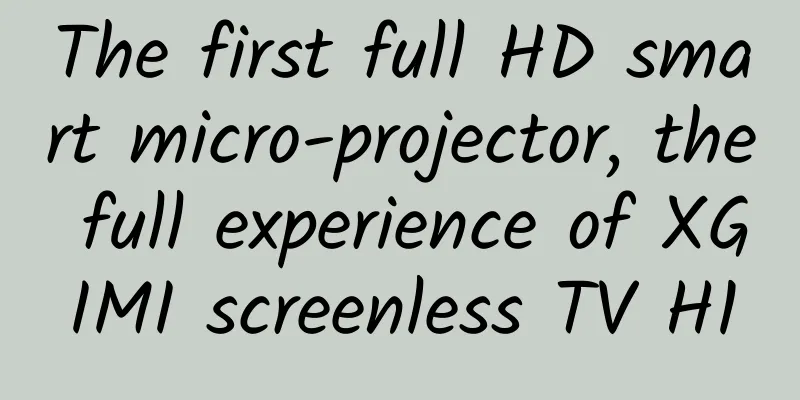The first full HD smart micro-projector, the full experience of XGIMI screenless TV H1

|
Where will the next development point of screen display be? In addition to the recently hotly discussed VR virtual reality, projection products that seem to be a certain distance from ordinary users have always been an option that must be mentioned. Fortunately, in recent years, with the efforts of some domestic brands, more affordable micro-projection products have shortened the distance between consumers and projection equipment. Xgimi, which first introduced the concept of "screenless TV", also officially launched its new flagship product H1 in 2016. As the first product in the domestic micro-projection industry with a physical resolution of 1080P, the Xgimi screenless TV H1 may be the first "true flagship" in the era of smart micro-projection. The product is 2.5 times the size of its predecessor, so why are there no complaints? The same metal appearance, but the XGIMI screenless TV H1 no longer has the flat and slim image of previous products. The dimensions of 200*200*120mm make it closer to a square box, and the upper and lower two-section body design even looks a bit like a rice cooker. If compared with its predecessor, the XGIMI Z4X, with similar length and width data, the thickness of the XGIMI screenless TV H1 is equivalent to two and a half times that of its predecessor, and the weight of the whole machine is about 2KG. It is not an exaggeration to say that the XGIMI screenless TV H1 is the least "micro" micro-projector product under the brand. The reason for this may be that the internal components such as the optical machine have a larger area on the one hand, and on the other hand, since the previous generation of products, the speakers certified by Harman Kardon have occupied a considerable volume, especially the left and right bass units on the top of the machine, which is very meticulously considered. As we all know, the most basic factor affecting the sound performance of a speaker is the volume of the cavity. From this point of view, the slightly larger XGIMI H1 screenless TV has a more obvious advantage. Therefore, we don’t think anyone will complain that this generation of XGIMI’s screenless TV products has "grown fatter". After all, you may have already been immersed in the virtual surround sound field released by the Harman Kardon certified speakers. In addition, another benefit of a larger body is that it is more conducive to heat dissipation and the design of external interfaces. The heat dissipation openings on the rear of the XGIMI screenless TV H1 are similar to those of some HTPCs. During use, the cooling fan is also quieter than before. A total of seven different types of interfaces on the back, including two HDMI, one USB2.0, one USB3.0 and network cable, can fully meet the needs of daily use. The distance between each interface is also very wide, and they do not interfere with each other when used at the same time. However, it should be noted that the power adapter of the XGIMI Screenless TV H1 is still big and black, and is not refined enough compared to the highly designed product itself. Technology upgrade to solve the three major pain points of smart micro-projection Smart micro projectors have been around for quite some time, but many people still feel that they are not easy to use. The reasons are nothing more than three points: the brightness is insufficient, and the viewing effect during the day is not as good as that of a TV screen; secondly, the resolution is not high enough, and the general 720P physical resolution is difficult to reach traditional display screens; finally, as a smart terminal, performance parameters and system design are often perfunctory by manufacturers, and are far less user-friendly than smartphones and smart TVs. From a certain perspective, the XGIMI H1 screenless TV is designed to change these three points. First of all, in terms of brightness, the XGIMI screenless TV H1 reaches the international standard of 900 ANSI lumens, which is 320 ANSI lumens higher than the previous Z4X with outstanding brightness, and even more than three times that of the previous Z4. In terms of actual performance, the XGIMI screenless TV H1 lived up to expectations. Even if we use a 1000W photography light to illuminate its projected image, the image in the non-strong light center area can still maintain extremely high visibility. In general household daylight or lighting scenes, it is easy to show a projection image with excellent brightness. Secondly, in terms of resolution, the XGIMI screenless TV H1 uses 0.47” Texas Instruments DMD RGB-LED display technology, with a physical resolution of 1080P. When compared with the previous 720P projection device displaying the same picture, the improvement in display fineness is most obvious. (720P-XGIMI Z4X) (1080P-XGIMI H1) Although traditional televisions have long been on the road to popularizing 4K, they can only project a 200-inch full HD picture at a distance of more than 6 meters. It can be said that the XGIMI screenless TV H1 further makes up for the shortcomings in resolution of micro-projection products while continuing the "large" picture. Finally, in terms of intelligence, the XGIMI screenless TV H1 is equipped with a flagship smart TV configuration with an Mstar 6A928 processor and a 3GB+16GB memory combination, which lays a good foundation for an excellent operating experience, and 4K video playback is not a difficult task at all. GMUI, developed based on Android 5.1, has gone through many iterations and has found a good balance in large-screen interaction. The first impression of the v1.4 version of GMUI on the XGIMI screenless TV H1 is that it is very similar to the Xiaomi MIUI TV version, but GMUI is more particular about details. The main interface is also a Launcher with a long horizontal flow. The remote control button to the left is for external signal source selection, and to the right is the APP desktop. Some quick operations will be called up, such as Wi-Fi, Bluetooth settings, etc. It is particularly worth mentioning that GMUI also retains the one-click clearing function of background tasks similar to the native Android style. Given the characteristics of the Android system, this ensures the smoothness of the system in the long term. As for the remote control that comes with the device, the XGIMI Screenless TV H1 is no different from its predecessor. Frankly speaking, this Apple-style metal remote control performs outstandingly in all aspects, and there is really not much reason to replace it. In terms of content, the XGIMI screenless TV H1 is completely at the same level as a mainstream smart TV. It has a large number of movies and TV series from Mango TV, a music library from Baidu Music, and a large number of TV games that support controllers or the XGIMI mobile screenless assistant. In particular, the addition of pre-installed applications such as "LeTV Cast" brings new gameplay on smart TVs to smart micro-projectors, demonstrating that the screenless TV is also an excellent screenless smart TV. The price of XGIMI screenless TV H1 is nearly 5,000 yuan, and the cost performance is still outstanding The official guide price of the XGIMI screenless TV H1 is 4,999 yuan. It is not only the more expensive product among XGIMI's screenless TV products, but also firmly ranks in the first echelon in the market of domestic smart micro-projectors.
So, is the XGIMI screenless TV H1 really expensive? In fact, from a horizontal point of view, it is still a product with outstanding cost performance. Before XGIMI launched H1, DLP projection devices with 1080P physical resolution have always been dominated by international brands. Taking products with similar parameters as an example, the LG PF85 and PF80 series are positioned between 10,000 yuan and 20,000 yuan. Of course, this price does not include Harman Kardon audio, high-end smart TV-level hardware and software configurations, etc. All in all, the XGIMI H1 screenless TV combines audio and video, software and hardware experience in one, coupled with a very competitive price. It is undoubtedly a choice worth putting on the shopping list, especially for projection enthusiasts who want to improve their viewing standards. As a winner of Toutiao's Qingyun Plan and Baijiahao's Bai+ Plan, the 2019 Baidu Digital Author of the Year, the Baijiahao's Most Popular Author in the Technology Field, the 2019 Sogou Technology and Culture Author, and the 2021 Baijiahao Quarterly Influential Creator, he has won many awards, including the 2013 Sohu Best Industry Media Person, the 2015 China New Media Entrepreneurship Competition Beijing Third Place, the 2015 Guangmang Experience Award, the 2015 China New Media Entrepreneurship Competition Finals Third Place, and the 2018 Baidu Dynamic Annual Powerful Celebrity. |
<<: Meizu M3s mobile phone review: Is it worth upgrading to fingerprint + metal shell for 100 yuan?
>>: IDC: The global WLAN market will grow 5.8% quarter-on-quarter in the third quarter of 2024
Recommend
Search for oCPX promotion suggestions when opening a Pinduoduo store!
Pinduoduo search oCPX is a promotion method of Du...
The system is smooth, and Jobs' last legacy has also been ruined. Android's closed source will solve the problem of lag once and for all
With the development of science and technology, p...
An article about ButterKnife to make the code more concise
Preface Android developers all know that each tim...
Follow the following principles and stop worrying about Xcode code signing issues
[[139309]] Thanks to the following habits, I have...
When connected to Wi-Fi, will the data flow still be "stolen"?
Many friends have always had a question: when the...
How much does it cost to customize a health care product mini program in Yongzhou?
According to industry insiders, mini programs wil...
From formation to snow accumulation, what are the differences between artificial snow and natural snow?
Ice and snow sports are becoming more and more po...
How to use AED and seize the golden 4 minutes of "sudden death rescue"?
On the evening of June 30, a young athlete from t...
MDSA offline open class will help you decipher high-performance APP development
With the fragmentation of people's demand for...
The mid- to long-term development plan of the automobile industry may become a breakthrough opportunity for domestic brands
Wu Songquan, director of the Policy Research Cent...
Misunderstood Marketing
If we go back to 2000, facing the backward econom...
It hurts to the bone! You must know this information about influenza B
[Danger! #Woman's two lungs turned white afte...
Shaxian is the empire of snacks, and Danxia is a world heritage site
Loading long image... Source: Authentic Scenery...
Promotion methods of APP new media marketing!
The basic tone of the APP operation and promotion...
Galaxy S6 Edge costs more than iPhone 6
Samsung's latest flagship smartphone, the Gal...









